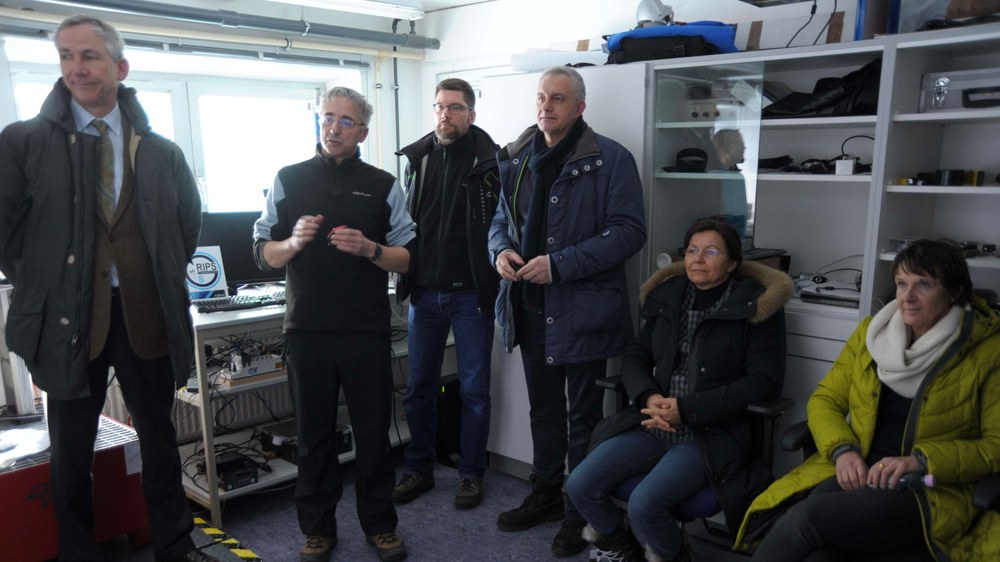Schneefernerhaus Environmental Research Station greets Bundestag Delegation and President Krautzberger of the German Environment Agency

Thanks to its high-alpine location the Schneefernerhaus Environmental Research Station (UFS) provides unique opportunities for environmental, climate, and high altitude research. On 20 February 2017 a delegation of the budget committee of the German parliament visited this research station on the Zugspitze, Germany’s highest mountain, accompanied by Maria Krautzberger, President of the German Environment Agency. There the visitors were informed about the research activities of the ten consortium partners, including the German Aerospace Center (DLR).

A welcome extended by Dr. Christian Barth, a department head in the Bavarian Ministry of the Environment and Consumer Protection and chairman of the UFS consortium’s advisory board, preceded a brief introduction. The science coordinator of the environmental research station, Prof. Michael Bittner, described the UFS science program as well as the "Virtual Alpine Observatory", a joint project of the high-altitude research stations in the Alps. Additional information was provided during a tour of the laboratories in the eight-story building. The guests were particularly interested in the GAW global station, which monitors the atmosphere as part of the worldwide network of the World Meteorological Organization (WMO). Uniting in such international networks is equally valuable to climate researchers and decision makers since it produces an extensive database useful when addressing global questions. The measurement data collected at the high-alpine Zugspitze location are also incorporated in the resources of the World Data Center for Remote Sensing of the Atmosphere (WDC-RSAT), which is based at DLR in Oberpfaffenhofen.
“Climate research is one of the most crucial present and future tasks” emphasised President Krautzberger of the German Environment Agency during the visit, a statement also confirmed by the Bundestag delegates. The delegates were particularly impressed at the interdisciplinary cooperation among the various institutions and research fields at “Schneefernerhaus”.
Current research activities
DLR uses the alpine research station to take long-term measurements and to carry out specific types of atmosphere monitoring. These include recording infrasound waves generated by heavy storms or volcanic activity. Together with the European Southern Observatory, DLR’s German Remote Sensing Data Center (DFD) is currently preparing to implement a tsunami early warning system for Chile. Since 2005 DFD has primarily operated the ground-based infrared spectrometer GRIPS on the Zugspitze:
One aim of the measurements is early detection of climate signals for such purposes as verifying the effectiveness of the Kyoto Protocol and improving climate and weather models. This includes monitoring temperature trends in the mesopause, a region at some 80 to 90 kilometre altitude that reacts very sensitively to changes like increases in carbon dioxide concentration. The GRIPS system is also a reference system in the international Network for the Detection of Mesospheric Change (NDMC), which includes 50 measuring stations in 22 countries and is coordinated by DFD.
To measure gravity waves, a custom-made infrared camera, FAIM, is also employed at the research station’s DLR lab. Especially when air flows over mountains, these waves form and then propagate upward to the top of the atmosphere, influencing global air circulation, temperature, and in the long range also the climate. Gravity waves have not yet been adequately taken into account in forecast models and for this reason they are a current research topic being investigated by the German Remote Sensing Data Center at Schneeferner glacier.
About the environmental research station
The Schneefernerhaus Environmental Research Station (UFS) is the "virtual institute" of a science consortium under the aegis of the Bavarian Ministry of the Environment and Consumer Protection. The ten consortium partners are, in addition to subsidiary Bavarian institutions, the German Environment Agency (UBA), Germany's national meteorological service (DWD), the German Aerospace Center (DLR), Karlsruhe Institute of Technology (KIT), Helmholtz Zentrum München - German Research Center for Environmental Health (HMGU), the Max Planck Society (MPG), Ludwig-Maximilians-Universität München (LMU), Technische Universität München (TUM) and Augsburg University. The infrastructure of the high-alpine research station is the responsibility of an operating company, UFS GmbH.

